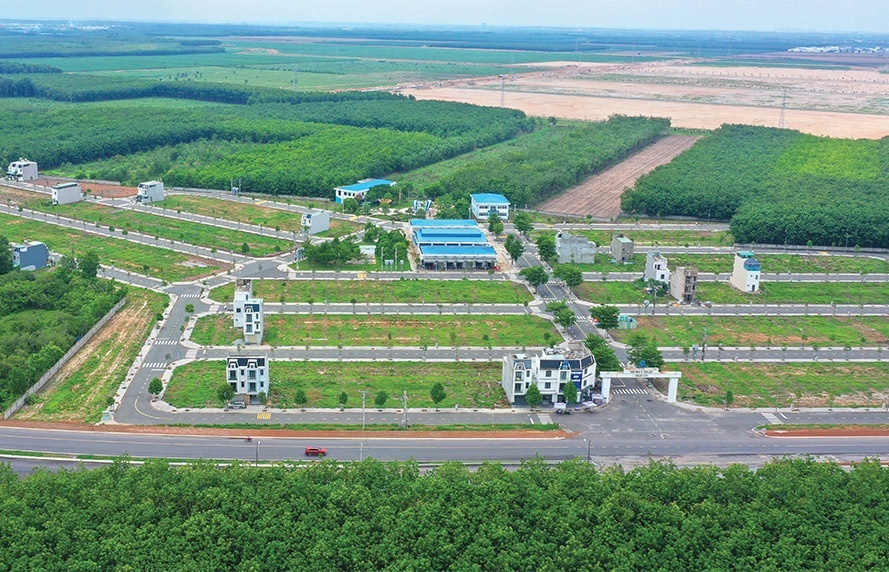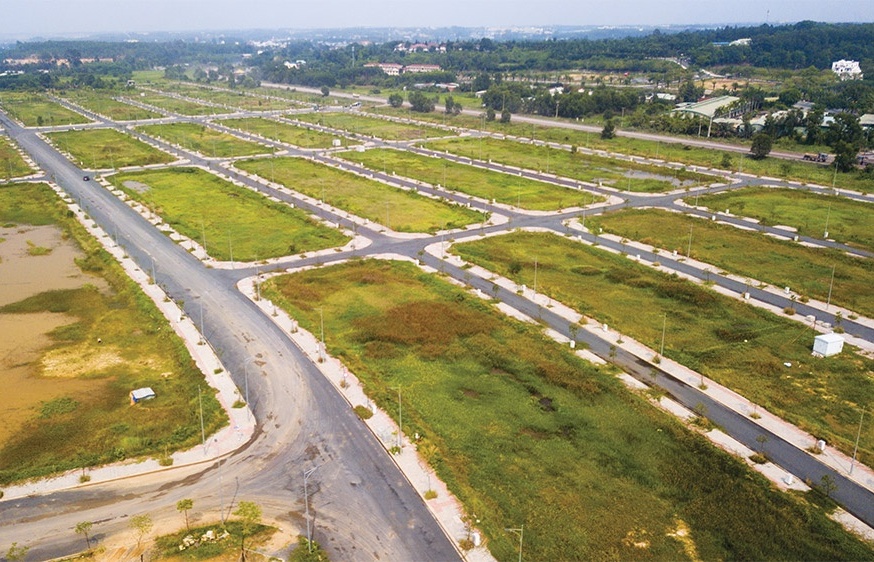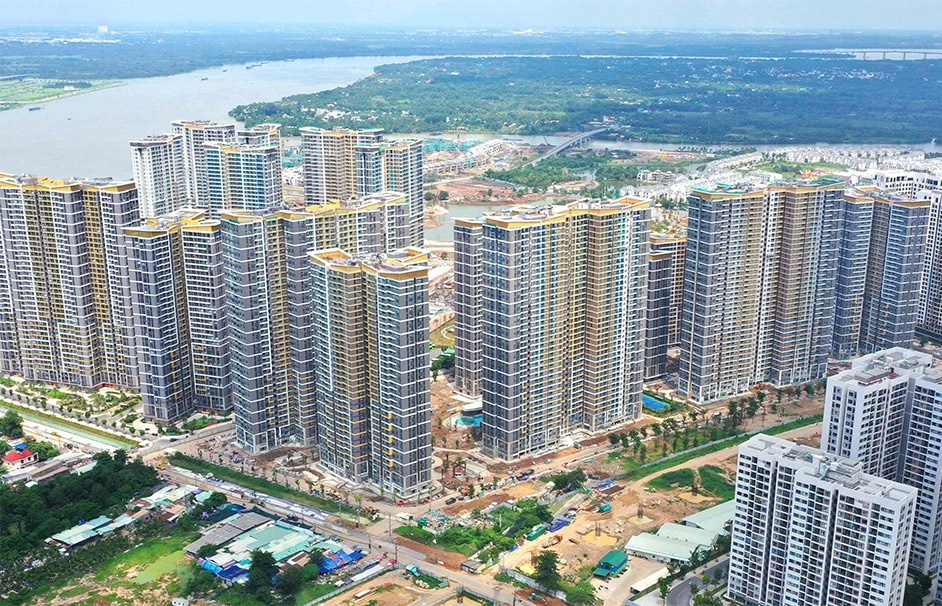Walking a fine line with old housing
Although new high-rise apartment buildings are springing up across the country every day, many Hanoi residents are stuck in dilapidated housing blocks built decades ago. Urban planners in the capital city are working on ways to redevelop these old compounds to improve living conditions, but this has not been an easy task, reports Ngoc Son.
At first sight it looks like a four-storey structure, yet closer inspection reveals that it is actually a five-storey residential block that is on the verge of losing an entire floor due to subsidence.
For residents like Nguyen Duc Y, there is no alternative but to stay in the sinking C1 Block in Thanh Cong residential quarter, even though they know their safety is threatened.
“This building was constructed in 1970s and it started sinking four years later,” said Y, a 20-year resident of this block in Hanoi.
The ground floor now measures about one metre high, which means 1.7m has disappeared into the ground.
“Our lives hang by a thread,” Y said, pointing to the crumbling and cracking walls of the building.
Residents in Nguyen Cong Tru Residential Quarter in Hoan Kiem District are also experiencing that sinking feeling. They have been living in a deteriorating environment of crumbling ceilings, cracking walls and rubbish heaps.
Thanh Cong is among 23 state-built residential quarters constructed in the 1960s and ‘70s in Hanoi to house state workers. Among these quarters there are a total 460 dilapidated blocks representing more than one million square metres of floor space. Most of these buildings have become slum houses and are home to more than 187,000 low-income earners who live with the constant hazards associated with degrading buildings, such as cramped spaces, crumbling ceilings and leaking pipes. Hanoi authorities have placed all these blocks on a list of dangerous apartments that require urgent upgrades or demolition to make way for new high-rise blocks. But inherent problems with these blocks have made the tasks of improvement and redevelopment incredibly difficult.
One of the first challenges relates to what should be simple calculations of the floor space of each flat because resourceful residents have carried out their own ‘renovations’ over the decades.
Tiger cages
‘Tiger cage’ is a slang reference to the cells built by the French colonists to jail Vietnamese nationalists. For many Hanoi residents of these quarters, tiger cages now describe what has happened after years of expanding families living in cramped conditions.
As the city’s population swelled from the gradual movement of people from rural areas, residents dealt with their shrinking living areas by using steel bars to transform balconies and corridors into kitchens, laundry rooms, play areas and places to hang plants.
“We are forced to build tiger cages. It gives us more space although we know that it could lead to the building deteriorating faster,” said Nguyen Tuan, a resident from the Thanh Cong quarter.
These additions create a headache for property developers who only want to compensate residents for the floor area provided under housing ownership certificates or purchase and lease contracts. If developers compensate for the extended space, redevelopment costs spiral and, in some cases, the extended area equals the original space. In Nguyen Cong Tru, for example, the total floor space for apartments is supposed to measure about 10,300 square metres, but residents have added more than 10,500sqm with tiger cages that encroach on public land.
Another issue arising from these possible redevelopments is defining the legal owners of apartments. Following the informal nature of most property transactions in Vietnam, many people who came from other provinces and are not legally allowed to buy houses in Hanoi have nonetheless managed to purchase apartments without registering with state management agencies.
Nguyen Van Quy, chairman of Thanh Xuan Bac District People’s Committee, said local authorities had not surveyed how many people had residence certificates and how many of these come from other provinces but have still managed to buy apartments.
Thanh Xuan Bac has a total 57 residential blocks built in the ‘70s and ‘80s, and all of these are in various stages of disrepair. Vinaconex, the country’s largest construction contractor, has expressed interest in redeveloping the whole area, but this is unlikely to happen soon as the corporation has to deal with some major hurdles first.
Finding the funds
Nguyen Dang Binh, deputy director of the Hanoi Department of Natural Resources and Environment, claimed it was time-consuming and expensive to upgrade or demolish old residential quarters in the city.
Municipal authorities have estimated the Nguyen Cong Tru compound alone would cost up to $200 million to demolish and rebuild. Improving living conditions at the city’s other 23 crumbling residential quarters would be too costly for the state budget to finance.
Binh said working out a plan to upgrade and redevelop old buildings mainly relied on state money, allocation of which has been slow because detailed development plans for each area have not been issued. At this time there are no official surveys or statistics about the real number and conditions of degrading residential blocks.
Nguyen Xuan Dao, managing director of consultants Vietnam Property, said foreign investors were not interested in rebuilding dilapidated residential compounds unless they garnered support from municipal authorities and local residents.
“These old compounds can be developed into new residential quarters for low-income people. However, Hanoi authorities should have means for investors to take part in the upgrade,” said Dao.
The property consultant said most of the problematic blocks were four and five storeys and he predicted investors would only be interested if they were allowed to redevelop these sites into 18- to 20-floor buildings.
“If an old block is rebuilt, the first four or five floors should be earmarked for existing residents, meaning that investors can only earn revenue from floors above this level and, as such, the higher the building, the more profits for developers,” he said.
Dao explained potential investors could also encounter additional difficulties negotiating compensation for those residents who live on the ground floors and often open street-side stalls or parking lots to earn a living.
When these buildings are rebuilt, ground floor residents are usually moved up to the first or second floors to make way for public services and facilities, which would mean these residents can no longer conduct these kinds of businesses and might be reluctant to relocate upstairs.
“As floor space in a revamped apartment is often bigger than the old one, the question of how to factor in the price difference is also a problem,” said Dao.
Deputy chairman of the Hanoi People’s Committee, Do Hoang An, is urging housing authorities to outline a mechanism that stimulates private investment in upgrading these dangerous buildings instead of solely relying on the state budget.
“The mechanism should be released by the second quarter,” An told a meeting with housing officials early this month.
Danger zones
Meanwhile, the risks associated with living in these deteriorating blocks continue to make local governments uneasy.
Capital city authorities were recently forced to relocate 40 households in Phuong Lien quarter’s P3 building in the district of Thanh Xuan into a newly built high-rise residential compound in Thanh Tri District.
The five-storey P3 building was only constructed in 1998, and in an appallingly short period had already started leaning so substantially that it was on the verge of collapse. Although the Phuong Liet residents ultimately emerged unscathed, other low-income residents have little choice but to live with the hazards these buildings present. With average monthly incomes of $70, they can not afford to buy a new apartment in Hanoi’s overheated housing market.
A new 50 sqm apartment in the capital costs at least $25,000 and it is highly unlikely that low-income earners would even be able to consider such a purchase, and another deterrent is that due to lack of supply and property speculation, average apartment prices can end up climbing to $30,000-40,000.
As Hanoians tire of living in these dilapidated quarters, many residents from other provinces dream of owning such a property because even a 40 sqm apartment in these old quarters, mostly located in the inner-city, can fetch up to $25,000.
But the real impetus for residents and authorities to step up the relocations is the perils of remaining, as one property developer in Hanoi, who declined to be named, said.
What the stars mean:
★ Poor ★ ★ Promising ★★★ Good ★★★★ Very good ★★★★★ Exceptional
Latest News
More News
- Trump's trade policies could shape Vietnam's economic outlook: Dragon Capital (November 15, 2024 | 16:56)
- The One Destination partners with Singapore investor and institutional fund to build ESG real estate complex (November 11, 2024 | 10:32)
- Stabilising measures must sit alongside land price hikes (November 07, 2024 | 09:56)
- CapitaLand Development records strong bookings for Orchard Hill (November 07, 2024 | 08:19)
- Public transport and real estate: The rise of Transit Oriented Development (November 05, 2024 | 15:06)
- Funding flows to second-tier localities (November 03, 2024 | 15:24)
- Hanoi has long road to travel in becoming a smart city (November 03, 2024 | 15:00)
- Nam Long Group hands over keys to Akari City Phase 2 (October 30, 2024 | 18:29)
- KTG Industrial expands industrial footprint at Taitronics 2024 (October 29, 2024 | 14:46)
- Deal signed for sustainable development at Prodezi Eco-Industrial Park (October 26, 2024 | 10:02)



















 Mobile Version
Mobile Version